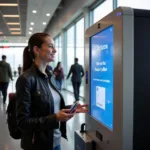1400 airport layouts encompass a vast world of airfield design, from small regional airstrips to sprawling international hubs. Understanding these layouts is crucial for pilots, air traffic controllers, airport planners, and even aviation enthusiasts. This guide dives deep into the intricacies of airport layouts, exploring their various components, design principles, and the factors influencing their evolution. Let’s take off on this informative journey!
Understanding the Basics of Airport Layouts
Airport layouts aren’t arbitrary. They are meticulously planned to ensure safe and efficient aircraft movement, passenger flow, and cargo handling. Key elements include runways, taxiways, aprons, terminals, and support facilities. Each element plays a vital role in the airport’s overall functionality.
Runway Configurations and Their Significance
Runways are the heart of any airport. Their configuration—single, parallel, intersecting, or converging—is determined by factors like prevailing winds, surrounding terrain, and projected air traffic volume. For example, parallel runways allow for simultaneous takeoffs and landings, increasing airport capacity, while intersecting runways might be more cost-effective for smaller airports with lower traffic volume.
Understanding how these configurations affect operations is key to grasping 1400 airport layouts. They dictate how aircraft arrive and depart, impacting everything from flight schedules to noise abatement procedures.
Navigating the Taxiway Maze
Taxiways are the arteries connecting runways to aprons and terminals. Their design aims to minimize taxiing time and prevent conflicts between aircraft. Efficient taxiway layouts are crucial for optimizing ground operations and minimizing delays. Imagine the complexity of a busy airport like mumbai airport location, where efficient taxiway management is essential for smooth operations.
Aprons and Terminals: The Passenger Interface
Aprons, where aircraft park for loading and unloading, and terminals, where passengers access the aircraft, are crucial for passenger experience. Their design needs to facilitate seamless passenger flow, baggage handling, and aircraft servicing.
Factors Influencing Airport Layouts: Beyond the Basics
Beyond the core components, several factors influence airport layouts. These include environmental considerations, security requirements, and future expansion plans.
Environmental Impact and Sustainability
Modern airport design increasingly prioritizes environmental sustainability. This includes minimizing noise pollution, reducing carbon emissions, and protecting local ecosystems. 50 busiest airports in the us are constantly striving to improve their environmental performance.
Security Considerations in a Changing World
Security is paramount in airport design. Layouts must incorporate security checkpoints, screening areas, and other measures to protect passengers and aircraft.
Future-Proofing for Growth and Technological Advancements
Airport layouts must be adaptable to accommodate future growth in passenger traffic and technological advancements. This includes provisions for larger aircraft, automated baggage systems, and evolving security technologies.
“A well-designed airport layout is like a well-oiled machine, where every component works in harmony to ensure safe, efficient, and sustainable operations,” says renowned airport planner, Sarah Johnson.
Conclusion: The Future of 1400 Airport Layouts
1400 airport layouts represent a dynamic and evolving field. As technology advances and air travel demands change, airport designs will continue to adapt. Understanding these layouts is not just about appreciating the complexities of aviation; it’s about recognizing the crucial role they play in connecting the world.
FAQ
- What are the main components of an airport layout?
- How do runway configurations affect airport capacity?
- What is the role of taxiways in airport operations?
- How do environmental considerations influence airport design?
- What are some future trends in airport layout design?
- How does security impact the design of an airport layout?
- What are some of the challenges in designing efficient airport layouts?
Need help with airport planning or have questions about specific layouts? Contact us at +13089626264, email us at [email protected], or visit our office at 404 Bothwell St, Oxford, NE 68967, USA. Our 24/7 customer service team is ready to assist you.
